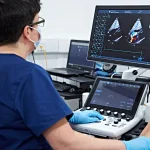A barium x-ray is a test to look at the outline of any part of your digestive system  .
.
Barium is a white liquid that shows up clearly on an x-ray. Once it is inside the body, it coats the inside of the oesophagus  , stomach or bowel. This then shows the outline of the organs on the x-ray.
, stomach or bowel. This then shows the outline of the organs on the x-ray.
If there is a tumour, it shows up as an irregular outline extending out from the wall of the affected part of the body.
Barium liquid does not do you any harm and passes through your digestive system so you don’t absorb it.
Why you might have it
There are several different types of barium tests. These include:
- a barium swallow – this is most often used to look at the inside of the food pipe (oesophagus) or stomach
- a barium enema – this looks at the large bowel (colon) and back passage (rectum)
Barium swallow
What it is
This is the name for the test that looks at the oesophagus and stomach. This test takes around 20 minutes.
Preparing for your test
You can’t eat or drink for a few hours before the test. You’ll get an appointment letter to explain when you need to stop eating and drinking. The exact time depends on the time of your test. If you’re not sure about anything, contact the x-ray department and ask the radiographer.
If you’re diabetic let your radiographer know. You may need to follow specific instructions. Or your appointment may need to change to suit you.
They will tell you if you need to stop taking any medication before the test.
What to expect
The test takes place in the x-ray department. You’ll be given a hospital gown to change into. You also need to remove any jewellery, glasses, metal objects or anything that may interfere with the x-ray picture.
You can bring a friend or relative with you for support. They can stay with you until you go into the x-ray room.
Once you are in the x-ray room, you drink the barium liquid. This is sometimes fruit flavoured but can taste a bit chalky.
The doctor (radiologist) or radiographer will want to take several pictures of you in different positions. They do this while you swallow the barium liquid.
You might have an injection of a drug called Buscopan during the test to slow down the movement of your bowel. This movement (called peristalsis) can change the scan and make it more difficult to read.
After your test
As soon as it’s over you can go home. You can also eat and drink normally.
Some people can get a little constipated after the test. To help prevent this, drink plenty of fluids and eat plenty of fruit and vegetables. You’ll also have paler or white poo (stools) the first couple of times you go to the toilet.
Some people feel a bit sick after a barium swallow. This should get better as the barium passes through your system.
Barium enema
What it is
You have a barium enema if your doctor wants to look at the inside of your bowel and back passage. This test takes around 40 minutes.
Preparing for your test
The day before the test, you usually need to take some medicine (a laxative) to clear out your bowel. You will have an information leaflet from the hospital to tell you how to take the laxative and what you can eat and drink. You may be told:
- to drink lots of fluids the day before the test
- not to eat any solid food on the day before
- not to eat or drink anything on the day of the test
What to expect
The procedure shouldn’t be too uncomfortable. But most people find this test a little undignified and embarrassing. Try not to worry, the staff looking after you understand how you may feel. They will put you as ease and have done this procedure many times before.
You change into a hospital gown before the test. You need to remove any jewellery, metal objects or anything that may interfere with the x-ray picture.
You might have an injection of a drug called Buscopan into your arm to relax your bowel muscles.
You lie on the x-ray table on your left side. The radiographer will put a small plastic tube into your back passage (rectum). This may feel uncomfortable, but not painful. Sometimes they inflate a small balloon to keep the tube in place.
The radiographer moves the x-ray machine into position above you. They then put barium and water through a tube. It’s important that you try to hold the liquid in your back passage. You’ll have the sensation of being full and wanting to open your bowels.
The radiographer will ask you to move or they will tilt the table so the barium spreads through the lower bowel. This shows up any lumps or swellings that they can see on the x-ray screen. They also put some air into the tube to inflate the bowel so that they get a clearer picture.
Most of the liquid barium drains back into the tube. Once they have taken all the pictures they remove the tube.
After your test
After the test you might have some mild cramping in your abdomen as the air they put in works its way out. You may also have some diarrhoea and want to use the toilet a few times before you leave. You might want to stay in the department for a little while after the procedure until you feel comfortable to leave.
Your first couple of stools (poo) will be white. They’ll go back to normal after the barium is out of your system. To help wash the barium out of your bowel, and prevent constipation, you should drink plenty of fluids and eat plenty of fruit and vegetables.
Possible risks
Having a barium swallow or barium enema helps doctors find out what may be causing your symptoms but, as with any medical procedure, there are possible risks. Doctors make sure the benefits of doing these tests outweigh any risks.
X-rays and radiation
An x-ray uses small amounts of radiation to take pictures of the inside of your body. The amount of radiation you receive from an x-ray is small and doesn’t make you feel unwell.
The risk of radiation causing any problems in the future is very small. The benefits of finding out what is wrong outweigh any risk there may be from radiation.
Talk to your doctor if you’re worried about the possible effects of x
You should not have these tests if you are pregnant.
Injection to relax the stomach or bowel
The injection you have to relax the stomach or bowel may cause temporary blurred vision. If this happens, you should not drive until your eyesight is back to normal.
You might not have this drug if you have glaucoma (increased pressure within the eye) or heart problems. The doctor or radiographer checks this with you when you go for the test.
Barium swallow
With a barium swallow, there is a risk that when drinking it a little bit may go down the wrong way and into your airway. This is very rare.
You can usually cough this up, but you may need physiotherapy to help.
Let the radiographer know if you have any problems swallowing.
Barium enema
During a barium enema, there is a very small risk of making a small tear in the bowel lining. This usually only happens if the bowel is severely inflamed.
Getting your results
You should get your results within 1 or 2 weeks at a follow up appointment.
Waiting for test results can be a very worrying time. You might have contact details for a specialist nurse who you can contact for information if you need to. It can help to talk to a close friend or relative about how you feel.



